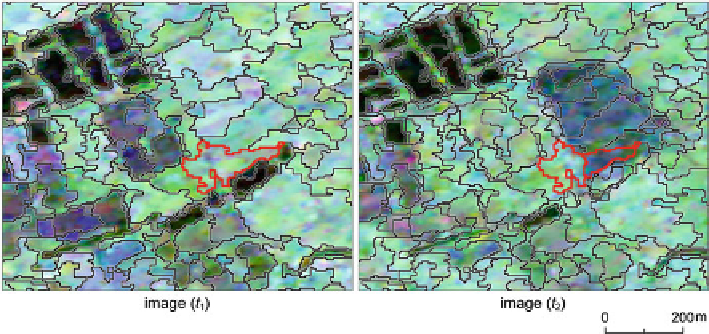Geography Reference
In-Depth Information
Fig. 19.3
Hierarchical
segmentation
for
delineating
image
objects
from
two
successive
RADARSAT-2 PolSAR images
process is implemented again on image (
t
2
) while the segmentation result of
image (
t
1
) is taken as the thematic layer for constraint. This procedure causes all
object-merging to take place within the boundaries of the segmentation of image
(
t
1
). As shown in Fig.
19.3
, new objects are only created in places where the
two images are significantly different (e.g., the red polygon in Fig.
19.3
). The
hierarchical segmentation technique could eliminate inconsistencies in delineating
image objects from two successive images. After the delineation of image objects,
change detection and classification could be conducted on the object level, and
different features could be extracted to support classification.
19.3.3
Combing Change Vector Analysis
and Post-classification Comparison for Detecting
LULC Changes
Post-classification comparison (PCC) is a commonly used change detection method
because it can provide information on both changed areas and the type of change
these areas undergo. However, the accuracy of PCC is limited by the accuracy of the
classification. It is still difficult to achieve high accuracy for LULC classification
using PolSAR images due to the speckle effect and limited spectral information
of PolSAR data. Combing unsupervised change detection methods and PCC can
reduce the impact of each individual classification on the change detection result and
provide information on types of change (Petit and Lambin
2001
). The unsupervised
approach can be used to detect changed areas and then PCC is used to determine
types of changes. Since PCC is only performed on detected change objects, the
hybrid method can greatly reduce false alarms caused by the error of independent
classification.

Search WWH ::

Custom Search